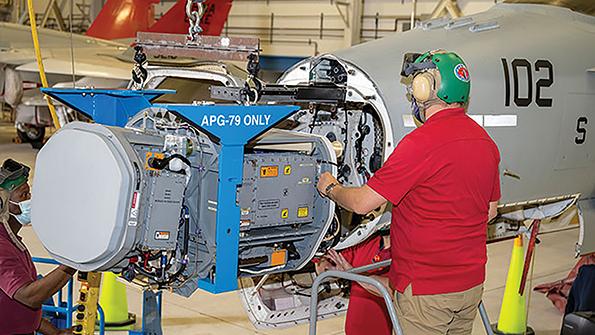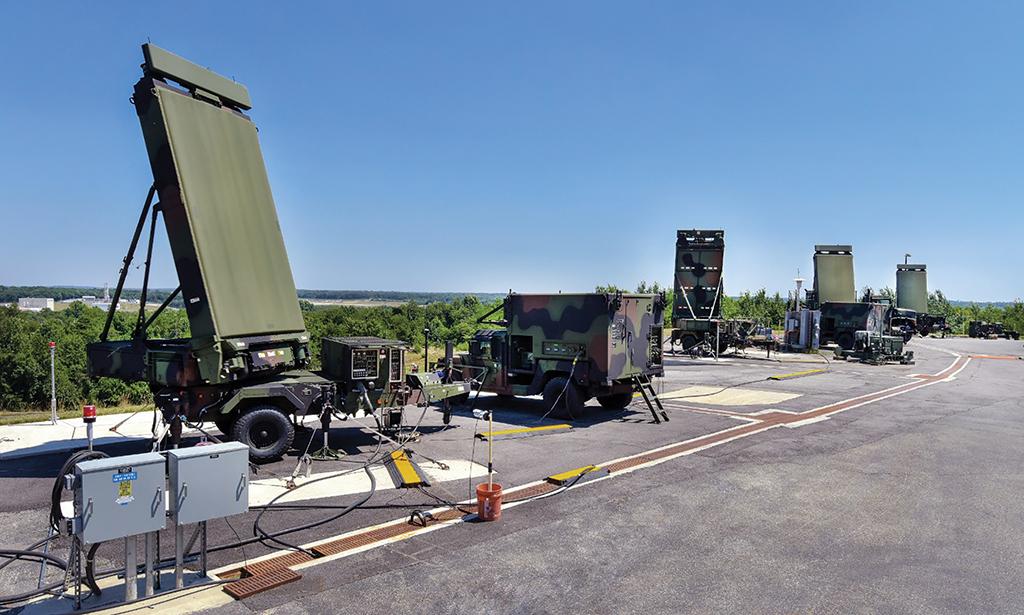
Gallium nitride, the semiconductor of choice for 5G electronics and large search radars, is on the cusp of transitioning into fighter aircraft’s fire-control radar, promising the single largest leap in performance since the active, electronically scanned array revolution in the late 1990s.
A technological shift from traveling-wave tubes to gallium arsenide (GaAs) chips enabled the packaging of active, electronically scanned arrays (AESA) into the cramped nose radomes of fighters two decades ago.
- Fighter radars poised for gallium nitride breakthrough
- APG-79(V)4 set for first GaN delivery by December
- GaN reopens design space for next-gen fighters
Now, far more powerful gallium nitride (GaN) technology is finally approaching critical mass for the same application. Advanced fabrication techniques have increased the hardiness and lowered the cost of GaN semiconductors, paving the way to introduce the monolithic microwave integrated circuit (MMIC) chips of a new generation of airborne phased arrays.
In the near term, GaN offers an opportunity to double the detection range of installed AESA radars on several fighter fleets, if power generation and cooling requirements can be met.
Longer term, the shift to GaN opens up design options for a new generation of combat aircraft. Instead of shaping the nose of a fighter around the cross section of the radar antenna, the extra power-added efficiency of GaAs’ powerful replacement may lead to installing a smaller array of transmitter/receiver modules up front and distributing networked, multifunctional apertures around the airframe.
In new fighter radars designed in France, Israel, Japan, South Korea, Sweden, the UK and U.S., GaN is already the most promising semiconductor material for the next generation of combat aircraft.
But the first fighter to enter service with a GaN-improved fire-control radar will not be an American Next-Generation Air Dominance, British Tempest, French or German Future Combat Air System, Japanese F-X, Korean KF-21 or Swedish JAS-39E/F Gripen. That distinction will instead belong to the U.S. Marine Corps’ aging Boeing F/A-18A-D fleet, an aircraft type still in service only because of delays with the Lockheed Martin F-35B/C.
In late April, Raytheon revealed that a two-year-old project to upgrade radar on the remaining F/A-18A-Ds to an AESA features the first application of GaN in a fire-control radar. As with most radio frequency (RF) device manufacturers, Raytheon has had more than a decade of experience in manufacturing the fickle GaN material; previous applications ranged from the ground-based Patriot radar to the airborne Next-Generation Jammer Mid-Band. But the APG-79(V)4 upgrade represents the first application of GaN in a fighter’s primary RF sensor.

As it was previously understood, the APG-79(V)4 in the F/A-18A-D Hornet represented merely a scaled-down version of the APG-79 AESA installed inside the larger radome of the F/A-18E/F Super Hornet. Radar range is a function of the size and the amount of power transmitted by the array. Although the array of the APG-79(V)4 is smaller than the APG-79, the application of GaN, a significantly more efficient semiconductor than GaAs, means that Raytheon can deliver a radar for the F/A-18A-D fleet with similar performance as the F/A-18E/F’s radar.
“We can bring in the gallium nitride capability onto that platform, and it provides the same detection range and capabilities that you see on the Super Hornet,” says Eric Ditmars, vice president of Secure Sensor Solutions for Raytheon Intelligence and Space. “You couldn’t do that with a standard GaAs chip. You have to go to GaN in order to gain the efficiencies you need in that smaller footprint.”
The transition has not been straightforward. Using internal research and engineering funds, Raytheon has converted the GaAs-based MMICs in the transmit-receive modules of the APG-79 to GaN, which Ditmars describes as a “very challenging technical problem.”
The greater efficiency of an array of GaN-based transmitter/receiver modules means that more power is being transmitted at the aperture face. As power rises, so does the temperature on the face of the array. The extra heat would overwhelm the forced-air cooling system installed in the radome of the F/A-18A-D, so Raytheon has also installed a liquid cooling system.
“You do need to make sure that you’re bringing the right amount of cooling solution into that system to take the heat out so that the circuits perform at their optimal level and keep them at the right temperatures for both performance as well as for reliability,” Ditmars says.
The Marine Corps has ordered 25 APG-79(V)4s, and Raytheon plans to deliver the first radar in December. The F/A-18A-D, however, is only the first step with GaN in Raytheon-designed fighter radars, Ditmars says. The next logical step is to upgrade the APG-79 on the F/A-18E/F with GaN.
“If you take this V4 configuration that’s currently sized for the Marine Corps and then incorporate that on the Super Hornet, for example, and get that array back to that larger size, then we’ll see even more performance improvements,” Ditmars says.
The exact numbers are classified, but in general terms, the greater power-added efficiency of GaN compared with GaAs “roughly doubles the detection range with the same size, same aperture and the same amount of power,” Ditmars says.
In a way, the advent of GaN arrays could make fourth-generation fighters such as the F/A-18E/F more relevant as adversaries deploy ground-based air defenses and air-to-air intercept missiles with longer range. The F/A-18E/F lacks the extent of stealth technology embedded into the Lockheed Martin F-22 and F-35, so maximizing the range of the fire-control radar may become a priority.
The same principle could also apply to another service using fighters with Raytheon radars. The Air Force is now fielding the Boeing F-15EX with the APG-82 AESA radar but last December issued a request for information seeking a broad range of potential upgrades. Raytheon responded to the solicitation with ideas for applying GaN to the APG-82, Ditmars says. Follow-up discussions with the Air Force about future radar upgrades for the F-15EX began in early June, he adds.
The ultimate prize for radar manufacturers, however, is the next generation of combat aircraft. In the U.S., the Air Force and Navy are developing replacements for the F-22 and F/A-18E/F, respectively. A highly stealthy aircraft should be able to approach a target more closely without being detected, reducing the range advantage of a GaN-enabled radar. GaN-based sensors offer other benefits, though, including the ability to use smaller arrays and employ frequency-hopping techniques over a broader portion of the spectrum than GaAs.
“Having the wider band allows you to frequency-hop to make sure [you aren’t] staying on one particular frequency, which makes [you] easier to detect,” Ditmars says.
Radio frequency sensor technology will evolve in the next generation of fighters. A network of multifunctional apertures capable of sensing, jamming and communicating will be distributed across a network of fighters instead of a single aircraft.
“As you move to more conforming materials and other technologies that are out there, you can effectively put an antenna anywhere,” Ditmars says. “Beyond that is the ability to actually coordinate separate antennas to work together, so you can have [a radar] on one aircraft as well as maybe on a wingman coordinate a more complex solution. As you start to network those different arrays together, you can do some very interesting things that allow you to both stay undetectable and what we might call ‘sanitize’ the airspace.”
Raytheon’s forward-leaning approach to applying GaN in existing fire-control radars may not be universal. Northrop Grumman—the supplier of the APG-83 radar for F-16s, the APG-77 for the F-22 and the APG-81 for the F-35—does not comment on whether the upgrade road map for existing systems includes a transition to GaN. Greg Simer, Northrop’s vice president of air dominance and strike, says the company is committed to applying GaN where it makes sense. “I don’t know the specifics for those legacy Hornets and what were the design drivers and requirements that led to them going down the GaN path,” Simer says, referring to Raytheon. “But each of the air vehicles have unique restraints and requirements that make it possible in the right place.”
Israel Aerospace Industries’ Elta Systems division, another fire-control radar supplier, confirms that the company has applied GaN to a fighter array but offers no specifics. Israel Lupa, vice president of research, development and innovation, says: “You can say that we are also implementing that technology in airborne [applications], including fighters.”






Comments